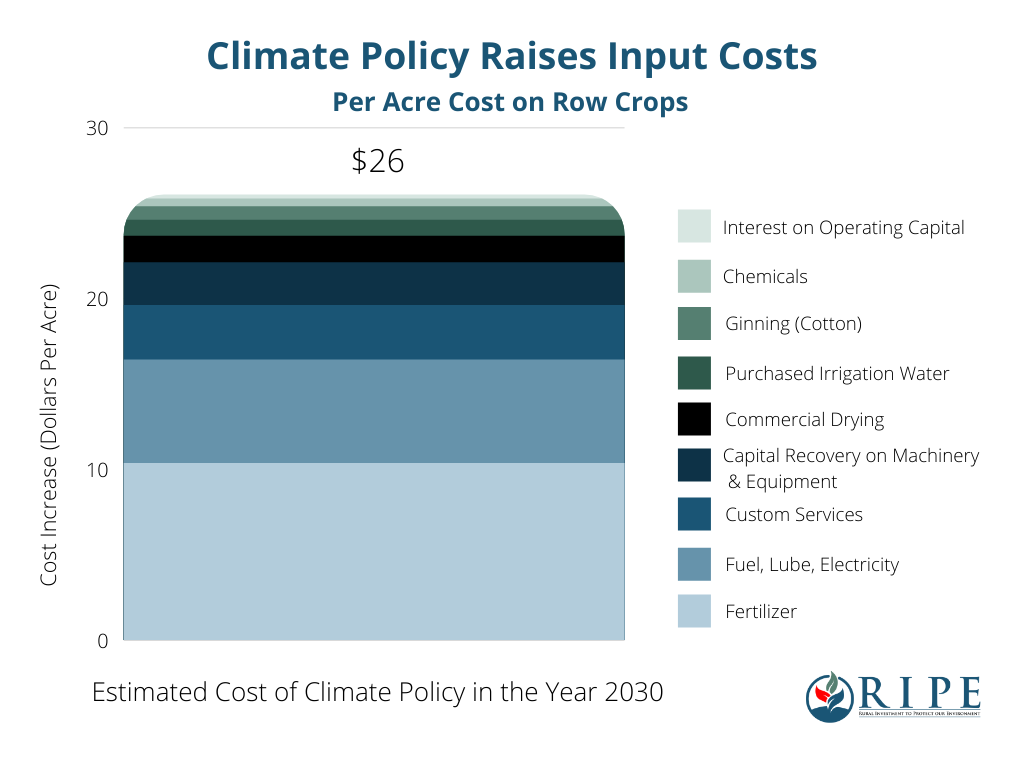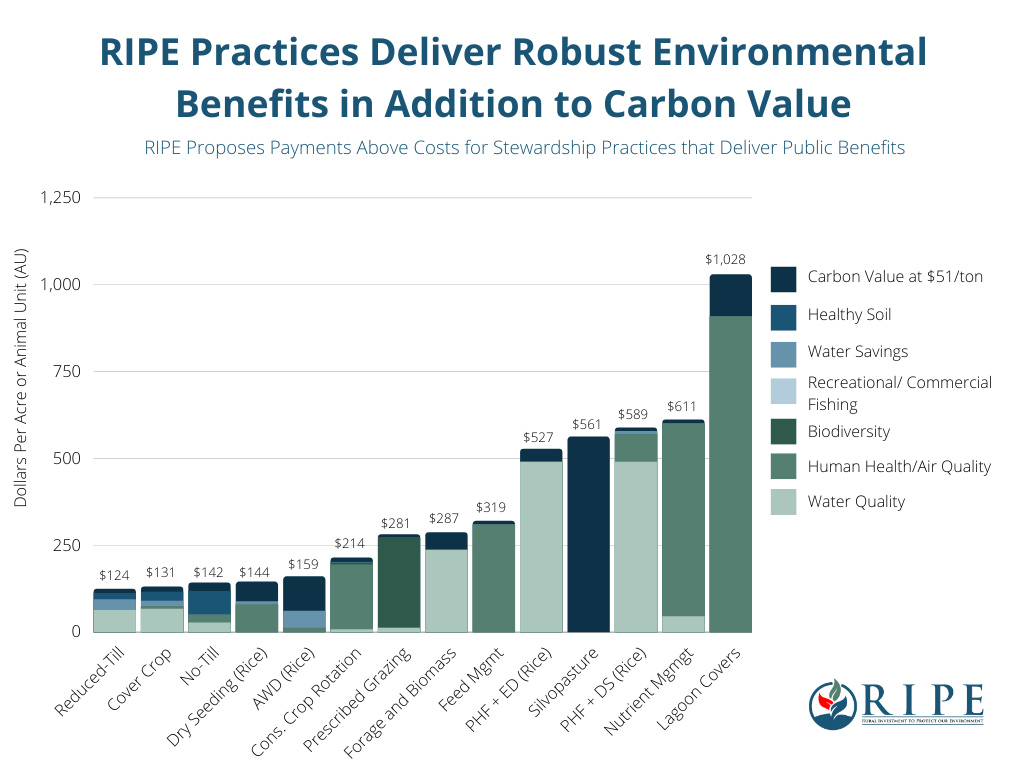How much money is RIPE proposing for farmers and ranchers?
Instead of cost-share, RIPE’s proposal would pay for costs of implementation, economic losses during transition to new practices and increased input costs combined.
All RIPE-approved practices will deliver public benefits — including soil health, clean water, water conservation, wildlife conservation and climate mitigation — that exceed payment value.
Does the policy stipulate a cap on enrolled acres?
Why do we need a new USDA program?
Current USDA conservation programs include many aspects RIPE seeks to draw upon. These include stewardship practice protocols, farmer self-verification and USDA technical expertise. However, none of the working land programs compensate at levels that reflect the public benefits delivered. Nor do they fully account for the expenses farmers incur through practice adoption and increased input costs due to climate policies.
The RIPE proposal provides farmers with profitable compensation that reflects the environmental benefits they deliver.
How will this policy be funded?
RIPE is focused on delivering a program that fairly rewards producers for the public benefits they provide and at rates that surpass climate policy costs. With this in mind, the RIPE Proposal would scale to work with any range of funds Congress chooses to invest.
A key program principle is that no funding would be pulled from existing program buckets. Instead, we see the Farm Bill as a great option to insert a small program to demonstrate proof of concept while ultimately using other vehicles to invest in the full program. With more major climate bills on the horizon, a small percentage of what Congress is looking to spend on climate would allow ALL producers to voluntarily participate in the RIPE’s program.
Why are carbon farming payments not enough?
The cost of a climate policy on agricultural inputs plus the cost of adopting stewardship practices will total around $67 per acre for many producers. Carbon farming payments will only deliver around $17 per acre to producers (at a carbon price of $50 per ton), leaving them with a net loss. However, farmers and ranchers who adopt stewardship practices deliver public benefits around $100-$300 per acre when stacking the ecosystem services such as soil health, climate, water quality, biodiversity, and more.
RIPE advocates for allowing producers to earn the stacked ecosystem service value of their voluntary practices, delivering value to the public and the grower.
Across the biggest U.S. commodities, the average cost of a climate policy would be $52 per acre. Looking across the spectrum of carbon farming practices, the average value is around $48 per acre, leaving most growers with a net loss. But that includes practices that most producers would likely not implement, such as biochar. If we only include practices that are popular with producers, then the average per-acre payment drops to $12. For most farmers and ranchers, the math of carbon farming payments alone simply doesn’t work.
How does RIPE differ from the private carbon market?
RIPE’s proposal does not conflict with private markets. It would allow farmers to retain their environmental assets and sell them to private actors while participating in the RIPE program. RIPE builds on the work of the private market and differs in the following ways:
- Guaranteed and Larger Scale – The RIPE proposal would be a USDA program that guarantees payment for all participating farmers at a larger scale than the carbon market.
- Guaranteed Price – Private markets fluctuate payment terms based on buyers’ interests, while RIPE’s proposed USDA program would ensure payment levels upfront.
- No Expensive or Intrusive Farm-Level Monitoring – Evidence of impact will be evaluated at the program level, not the farm level. The program would follow existing protocols at USDA of self-certification with a 5% audit rate.
- Larger Payments – Private actors pay farmers for the greenhouse gas value. RIPE proposes $100-per-acre payments, which include the values from greenhouse gas and water quality, biodiversity, soil health, and other ecosystem services.
- No Penalty for Early Actors – The policy would include systems that farmers have already implemented.
How does RIPE help farmers manage climate change?
RIPE’s proposal would help farmers manage climate change and climate change policy. First, it would fully and fairly compensate farmers for investing in voluntary farm stewardship practices that help them adapt to flooding, droughts and other extreme weather patterns that are part of a changing climate. Practices such as cover crops and water conservation would be fully compensated. Second, U.S. farmers will experience increased costs from climate policy. Fuel, fertilizer and other inputs will continue to rise. The RIPE proposal would cover those costs in addition to paying for the public environmental benefits like improved water quality and soil heath, increased biodiversity and more.

Can ranchers who lease land from the Bureau of Land Management (BLM) participate in the RIPE program?
Yes. RIPE’s proposal is designed to allow all farmers and ranchers to participate, including those who use BLM lands for grazing.
BLM requires renters to specify their practices in the lease, so ranchers must check their lease to ensure the allowance of new practices they would like to adopt. The RIPE proposal includes practices that have been approved by BLM in ranching leases, when requested, such as: cover crops on grazing lands, riparian forest buffers, filter strips, livestock forage and biomass planting, riparian herbaceous cover, nutrient management plans (state or national protocols), and maintaining native grasslands. If the lease does not include these or similar practices, ranchers can integrate them when renegotiating their lease with BLM, thus enabling participation in RIPE’s program.
Additionally, RIPE supports partnering with ranchers and ranching associations to engage BLM in amending its regulations to allow ranchers to add conservation practices prior to their lease renewals, based on the precedent that BLM encourages permit holders to be stewards of the land they rent.
Does the RIPE proposal help with flood mitigation?
Yes. RIPE’s proposal includes farm practices that mitigate flooding and would compensate farmers fairly for their implementation.
Flood mitigation practices compensated by RIPE’s plan include cover crops, reduced tillage, rotational grazing, silvopasture and riparian buffers. These practices:
- Increase water infiltration into the soil rather than allowing the water to run across the land, reducing flood depth and duration on frequently flooded lands, especially in alluvial river valleys and areas with hydric clay soils.
- Hold soil in place during flooding. This prevents sedimentation in waterways and overland flow, and it reduces the amount of standing water on fields and pastures.
- Reduce polluted waterways caused by flooding. Pesticides and fertilizers, carried as runoff, damage fishing and recreation, as well as aquatic and terrestrial biodiversity.
How can I get involved with RIPE?
We welcome your involvement!
- Subscribe to our newsletter
- Talk to your commodity about including the plan in their Farm Bill platform. Resources are available in our Volunteer Toolkit
- Follow RIPE on Facebook, Twitter, LinkedIn and YouTube and join the conversations
- Connect with the RIPE Outreach Team by contacting GetInvolved@RIPEroadmap.org
- Join the Farmer Advisory Network
- Make a donation
What is the stacked ecosystem service value?
RIPE proposes paying farmers in alignment with the stacked ecosystem service value of stewardship practices whose minimum is $100 per acre or animal unit. Farmers would be paid not just for their carbon, but also for the water quality, air quality, biodiversity and other ecosystem services they provide. As illustrated in the chart below, the value to the environment and society from one acre that is sustainably farmed is significant.

